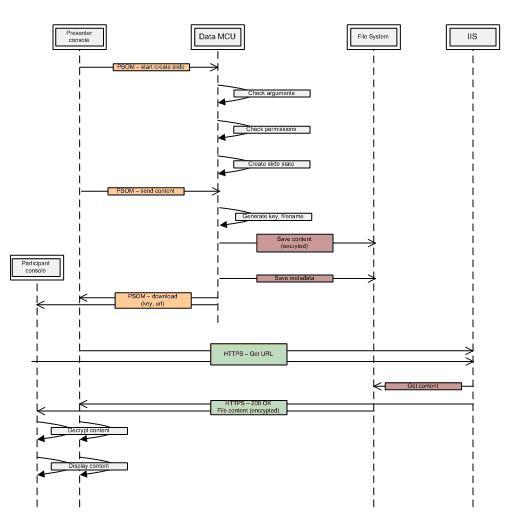When the actual content for a slide is uploaded to the Web Conferencing Server, the client uses a stream to send the data from the local computer to the Web Conferencing Server. The stream mechanism is built on top of Persistent Shared Object Model (PSOM) to send, in real-time, a large amount of data. (PSOM is typically used to send only small pieces of data, such as integers and short strings.)
When the content of slides uploaded to the server over PSOM must be accessed by conference participants, HTTPS is used to download the content.
For example, PowerPoint slides, Word documents, and handout slides (that is, file transfers) all require participants to transfer from the Web Conferencing Server a significant amount of data, including images and original documents. For these types of slides, the data is transferred to clients using the Web Components Server. First, the Web Conferencing Server writes the content to the shared folder for conferencing content. (The folders where the content is saved are encrypted.) Then, the Web Conferencing Server sends clients in the conference the URL and the encryption key for the content files. Each participant uses this URL to download the content from the Web Components Server. Using the encryption key, each participant decrypts the content and displays it in the Live Meeting window.
The following figure shows the data flow when clients download conference content over HTTPS.

The upload process is similar to the one whereby the content is downloaded over PSOM. The difference is that the Live Meeting client always sends content to the Web Conferencing Server in a separate step, as a stream over PSOM.
After the Web Conferencing Server receives the content stream from the presenter, the Web Conferencing Server generates a random encryption key and file name for the content and saves the content into the content folder on the shared file system. After the content is saved to the file server, the Web Conferencing Server sends the encryption key and file name to the client. The client sends a GET request to the Web Components Server. Since the Web Components Server is configured to use the same content folder, Internet Information Services (IIS) is able to resolve the request and send the client the encrypted content. The Live Meeting client then decrypts the content and displays it.







